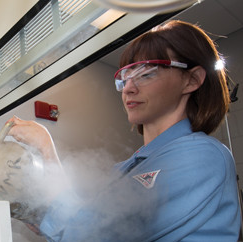How do We Kill Cancer Cells? (part 1)
Lesson Overview

Students will begin by sharing their previous knowledge about cancer and how it behaves and how it is treated. They will then use social media to contact Dr. Rachel so she can share her current research on how we can identify cancer cells that are playing hide-and-seek with the immune system. Students will then use yeast, a rapidly reproducer of cells, to model as cancer, and will plan and carry out an investigation using a common household product to try to slow down the rapid division of yeast cells. They will collect data on a control and a yeast sample treated with their household product. Students will analyze and interpret this data and then compare their model of an experiment to the work that Dr. Rachel is doing in the lab. They will share these findings with each other and see if they can identify any patterns in their findings. Students will be assessed on the conclusion that they hand in with their lab write up.
About the Scientist

Rachel Willand-Charnley
Institution: South Dakota State UniversityHello! I am a new assistant professor in the department of Chemistry and Biochemistry at South Dakota State University. I recently moved here after finishing my postdoctoral fellowship at Stanford University. I am an interdisciplinary scientist, my lab performs research in cancer immunology, glycobiology, chemical biology, and organic chemistry. Right now, we are currently investigating how various cancers utilize simple sugar residues to evade the immune system and using organic chemistry to build sugar-based inhibitors. I enjoy performing research in the lab, as well as, being a mentor and teacher. Having a firm grasp of fundamental chemical principles in the classroom is essential when addressing high-impact problems through research. In addition, having a large pool of diverse minds solving these high impact problems. As a result, I believe that diversity is key to scholarly advancement. One of my primary goals as an assistant professor is to foster and promote the development of a diverse assembly of future scientists who will address our research needs. I am pleased to be a part of SD EPSCoR's STEM Education Portal because I am able to generate lesson plans that can be implemented in the class room across the state thus helping me to reach my goal!
 National Science Foundation RII Track-1 Project:Expanding Research, Education and Innovation in South Dakota
National Science Foundation RII Track-1 Project:Expanding Research, Education and Innovation in South Dakota